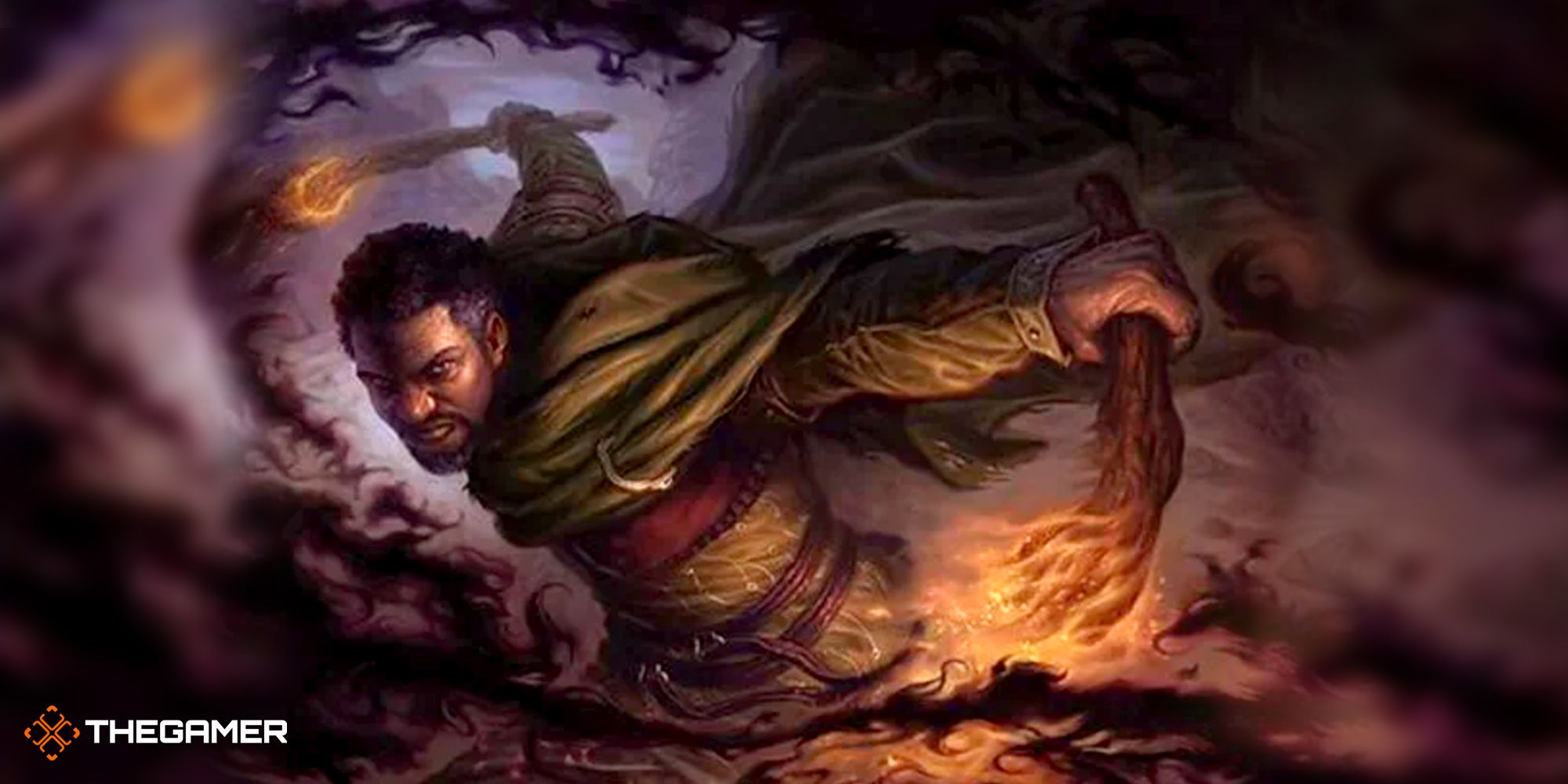Dungeons & Dragons has two types of druids. One likes to turn into animals and tear through goblin camps with tooth and claw, and the other prefers to wield the power of nature to cleanse the land of evil. A Circle of the Land druid is definitely in the latter camp.

Related
Dungeons & Dragons: How To Build A College Of Whispers Bard
Reveal a monster’s dirty secrets as this subtle bard subclass.
If you want to be a dedicated spellcasting druid, then you’ll want to join the Circle of the Land. Your druid will receive powerful new spells, depending on the type of land they’re from, and you’ll be able to draw upon nature to restore your spell slots in a similar to wizards. Read on to learn how to become the ultimate nature-themed support caster by joining the Circle of the Land.
Updated on December 17, 2024, by Alfredo Robelo: Druids from the Circle of the Land continue to be master spellcasters, but using them with the updated 2024 Player’s Handbook rules has its fair share of differences. We’ve updated this article to include said differences, covering everything you need to know to become a spellcasting druid with the new rules.
Circle Of The Land Druid Features
Joining the Circle of the Land unleashes the full arsenal of nature’s magic. Starting at level two, you learn an additional cantrip as well as Nature’s Recovery, which lets you regain spell slots equal to half your druid level rounded down with each short rest.
Starting at level three, you begin to learn additional Circle Spells. The spells you learn will depend on your chosen land, which are detailed in the tables below.
Arctic
|
Druid Level |
Spells |
|---|---|
|
Third Level |
|
|
Fifth Level |
|
|
Seventh Level |
|
|
Ninth Level |
|
Coast
|
Druid Level |
Spells |
|---|---|
|
Third Level |
|
|
Fifth Level |
|
|
Seventh Level |
|
|
Ninth Level |
|
Desert
|
Druid Level |
Spells |
|---|---|
|
Third Level |
|
|
Fifth Level |
|
|
Seventh Level |
|
|
Ninth Level |
|
Forest
|
Druid Level |
Spells |
|---|---|
|
Third Level |
|
|
Fifth Level |
|
|
Seventh Level |
|
|
Ninth Level |
|
Mountain
|
Druid Level |
Spells |
|---|---|
|
Third Level |
|
|
Fifth Level |
|
|
Seventh Level |
|
|
Ninth Level |
Grassland
|
Druid Level |
Spells |
|---|---|
|
Third Level |
|
|
Fifth Level |
|
|
Seventh Level |
|
|
Ninth Level |
Swamp
|
Druid Level |
Spells |
|---|---|
|
Third Level |
|
|
Fifth Level |
|
|
Seventh Level |
|
|
Ninth Level |
Underdark
|
Druid Level |
Spells |
|---|---|
|
Third Level |
|
|
Fifth Level |
|
|
Seventh Level |
|
|
Ninth Level |
The Land you choose is up to you, but Arctic, Desert, Grassland, Mountain, and Underdark have the most useful spells.
Land’s Stride at level six allows you to move through nonmagical difficult terrain without any additional movement cast. You also don’t take damage from nonmagical plants that have thorns, spikes, or other hazards. You also have advantage on saving throws against magically created plants that try to impede your movement.
Nature’s Ward at level 10 makes you immune to charm and fear effects from elementals and fey, as well as immune to all poison and disease.
Finally, Nature’s Sanctuary at level 14 forces plants and creatures to make a Wisdom saving throw in order to attack you. On a failed save, they have to choose a different target or the attack misses.

Related
Dungeons & Dragons: 7 Playable Species That Can Fly
Take to the skies with these Dungeons & Dragons species.
Differences In The 2024 Player’s Handbook
While the subclass still functions as the main way to be a spellcasting druid, the 2024 version of it completely changes your relationship with the lands. There are less to choose from, all of which are new choices without a clear 2014 mirror, but you can swap your chosen land after a long rest.
Arid Land
|
Druid Level |
Spells |
|---|---|
|
Third Level |
|
|
Fifth Level |
|
|
Seventh Level |
|
|
Ninth Level |
Polar Land
|
Druid Level |
Spells |
|---|---|
|
Third Level |
|
|
Fifth Level |
|
|
Seventh Level |
|
|
Ninth Level |
Temperate Land
|
Druid Level |
Spells |
|---|---|
|
Third Level |
|
|
Fifth Level |
|
|
Seventh Level |
|
|
Ninth Level |
Tropical Land
|
Druid Level |
Spells |
|---|---|
|
Third Level |
|
|
Fifth Level |
|
|
Seventh Level |
|
|
Ninth Level |
As you can see, while there are fewer spells on offer per land, you have more spells available to you as a whole, since you can swap lands around. There is no longer a mathematically perfect land, you just have to pick whatever fits your current adventure.
Consider your foes’ resistances and vulnerabilities when choosing a land, or at least what spells might benefit the party the most. If you want the most combat-ready land, then the Arid land is a solid choice, at least on the early levels.
One final new feature of these lands comes at level ten, tied to the expanded Nature’s Ward ability gained at that level. You are still immune to the poisoned condition (no mention is made of disease since that mechanic is not present in the 2024 books), but you also gain resistance to a damage type based on your current chosen land:
|
Land Type |
Resistance |
|---|---|
|
Arid |
Fire |
|
Polar |
Cold |
|
Temperate |
Lightning |
|
Tropical |
Poison |
Depending on the enemy you might face, you’ll have to decide what you value most: offense or defense. For example, fire resistance would be nice against Fire Elementals, but that would mean you have a bunch of fire-themed spells that will do them no harm.
Other Features
Natural Recovery, the way land circle druids recover spell slots, is now gained at level six. However, at the third level, these druids gain Land’s Aid, a feature that lets the druid spend a wild shape charge to create a space of thorny vines, damaging enemies and healing one ally.
Another big change is the level 14 feature, Nature’s Sanctuary. While the name remains the same, it now has nothing to do with beasts being hesitant to attack you; instead, you create a literal sanctuary made of vines around you, giving half cover to your allies, and having them share your Nature’s Ward resistance.
Best Species For A Circle Of The Land Druid
Any of D&D’s species can become one with nature. Feel free to play your Circle of the Land druid as any species you prefer, but there are a few species that offer some benefits to druids. Here are a few suggestions.
|
Autognome |
Druids can learn Mending, which can heal you without using a spell slot. Your Armored Casing will offer a base armor class of 13 when you’re not wearing armor, although you’ll have to be made of something other than metal. You’re already immune to poison and disease at level 10, but Built for Success is useful at every level. |
|---|---|
|
Elf |
You’ll mostly want to take the high-elf subclass to gain access to a wizard cantrip. Produce Flame is your best damage cantrip as a druid, but you can do better with a quick dip into another class’s spell list. Darkvision and perception proficiency are nice too. |
|
Fairy |
Faerie Fire and Enlarge/Reduce are great spells to have on hand, but the real draw here is being able to fly. Keep in mind you can’t fly while wearing medium armor. |
|
Firbolg |
A classic choice for a reason. Disguise Self and Detect Magic are great spells to have, and Hidden Step lets you become invisible for short periods. Speech of Beast and Leaf will let you talk to plants and animals, saving you a few spell slots. |
|
Fire Genasi |
Produce Flame is already your best damage cantrip as a druid, which frees up a cantrip slot. Burning Hands and Flame Blade are more situational. Darkvision and fire damage resistance are always useful. |
|
Goblin |
Fury of the Small works on spells and can go a long way toward improving your damage output. Darkvision is great, and so is being able to hide and disengage as a bonus action. |
|
Half-Elf |
Same as with elf, being a high half-elf gives you access to a more potent wizard cantrip like Fire Bolt. Darkvision and three stat boosts are also good to have. |
|
Harengon |
Hare-Trigger places you earlier in the turn order, perception proficiency is good to have, and Rabbit Hop gets you out of sticky situations as a bonus action. Lucky Footwork is good to have, but you’ll hopefully avoid Dexterity saving throws entirely by playing in the back line. |
|
Human |
Variant human lets you start the game with a free feat, like Magic Initiate, which will give you access to a more potent cantrip than Produce Flame. |
|
Kobold |
Draconic Sorcery gives you a sorcerer cantrip like Fire Bolt. Draconic Cry is nice to do in a crowd, but you should be letting your tanks deal with monsters. Darkvision is always a plus. |
|
Loxodon |
Loxodon’s Natural Armor lets you use your Constitution modifier to improve your armor instead of Dexterity, allowing you to completely dump Dex to improve your hit points, and concentration, and still be hard to hit. Loxodon Serenity prevents charm and fear effects, and Keen Smell provides three skill advantages so long as you can argue your nose is involved. |
|
Owlin |
Darkvision, stealth proficiency, and being able to fly are all you’ll ever need. |
|
Shadar-Kai |
A 30-foot teleport as a bonus action is great to get you out of trouble. Darkvision and necrotic damage resistance are also great. Fey Ancestry is less useful, but perception proficiency is always good to have. |
|
Thri-Kreen |
Secondary Arms means you can hold a wand, and a shield, and still have a hand free to cast the somatic components of spells. Chameleon Carapace provides extra armor class and advantage on hide checks, and both Darkvision and Telepathy are great for any character. |
Best Ability Scores For A Circle Of The Land Druid
You’ll need two things to be an effective Circle of the Land druid: Wisdom and Constitution. Wisdom empowers your spellcasting, and Constitution ensures you can maintain concentration on your spells and provides those all-important hit points.
Most druid spells require concentration, making Constitution doubly important compared to other spellcasting classes.
Dexterity is nice to have to shore up your armor class, but Strength, Intelligence, and Charisma can all be ignored.
If you’re using D&D’s point buy system, a decent starting ability score spread for a Circle of the Land druid might look something like this.
|
Strength |
Dexterity |
Constitution |
Intelligence |
Wisdom |
Charisma |
|---|---|---|---|---|---|
|
8(-1) |
14(+2) |
16(+3) |
10(0) |
17(+3) |
8(-1) |
Best Starting Equipment For A Circle Of The Land Druid
Everything you do should center around spells, so much of your starting equipment won’t matter. Choose a wooden shield over your first simple weapon, and then pick either a quarterstaff or a sling if you want to use either the Shillelagh or Magic Stone cantrips. Otherwise, pick a sword or a dagger so you can at least cut branches.
Shillelagh or Magic Stone aren’t ideal cantrips. They both require the use of your bonus action, and Shillelagh requires you to be in melee combat, which is not where a spellcasting druid should be. Produce Flame is your best damage cantrip, so feel free to pick whatever weapons you want since you won’t be using them anyway.
Leather armor, an explorer’s pack, and a druidic focus round out your adventuring arsenal.

Related
Dungeons & Dragons: How To Build A Monster Slayer Ranger
Relentlessly pursue your foes with this monster-slaying ranger subclass.
Best Spells For A Circle Of The Land Druid
As a pure spellcasting class, your spells are everything. You’ve got a lot of spells to choose from, so here are a few suggestions at each spell level.
|
Spell Level |
Spell |
|---|---|
|
Cantrip |
|
|
First Level |
|
|
Second Level |
|
|
Third Level |
|
|
Fourth Level |
|
|
Fifth Level |
|
|
Sixth Level |
|
|
Seventh Level |
|
|
Eighth Level |
|
|
Ninth Level |
|

Next
Dungeons & Dragons: How To Create An Adventure Using The 2024 Dungeon Master’s Guide
If you’re new to being a DM in Dungeons & Dragons, you’re in luck: the 2024 Dungeon Master’s Guide can help you a lot. Check out these tips!


















Leave a Reply